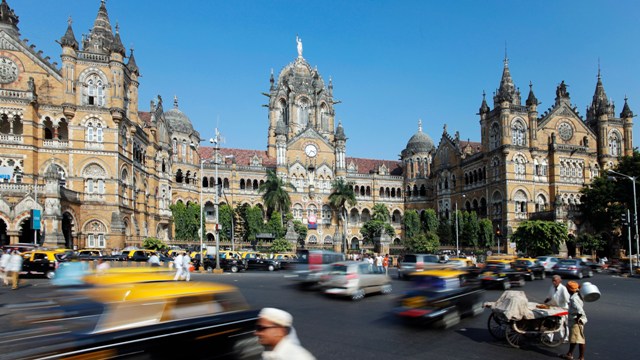 When Bombay became Mumbai, streets and buildings were renamed. Victoria Terminus became Chhatrapati Shivaji Maharaj Terminus. [photo: RobertHarding/ Alamy]
When Bombay became Mumbai, streets and buildings were renamed. Victoria Terminus became Chhatrapati Shivaji Maharaj Terminus. [photo: RobertHarding/ Alamy]
[This article appears in The Round Table: The Commonwealth Journal of International Affairs. Opinion articles do not reflect the views of the Round Table editorial board.]
There is a proposal to change the name of Jim Corbett National Park in Uttarakhand, North India, to Ramganga National Park. Ramganga was the original name and need never have been changed. But we have learned to live with the iconic Jim Corbett for over 60 years and the park is internationally famous.
Indians love changing names. Maybe that comes from the Indian tradition of renaming the bride at the wedding. For example, a Shankar cannot be married to a Radha, so her name would be changed to Uma or Parvati. As a result, many North Indian families do not name their children at birth and the poor kid goes through life as Babloo or Pinky till her future in-laws give her a name she may not even like.
When Madras Presidency broke up after the linguistic division of states, the Tamil part became Tamilnadu, Travancore-Cochin became Kerala and the Telugu regions were named Andhra Pradesh. Andhra Pradesh was made up of three regions: Andhra (coastal region), Telangana and Rayalaseema. If, like Tamilnadu, they had named the state Telugu nadu or Telugu desam, it may never have split. By naming it Andhra Pradesh, Telengana and Rayalaseema felt slighted, and Telengana asked for a separate state. So what’s in a name? Everything! I wonder when Karnataka, which consists of North and South Kanara, Coorg, Belgaum, Gulbarga, Mysore and Bangalore with a variety of languages like Kannada, Tulu, Kodava, Konkani and Beary, will see an upsurge of linguistic nationalism.
In 1998, Madras was renamed Chennai. Madras was the original fishing village which was leased by the Raja of Chandragiri, represented by Damarla Venkatappa Nayakar, to the British. Venkatappa slipped in a clause that the leased land would be named after his father Chenappa Nayakar, who never visited the city nor did anything for it. In fact, Chenappa was Telugu, not Tamil. In typical British fashion, the East India Company chose to ignore their promise and retained the name Madras. I wonder whose idea it was to rename the city as Chennai, for the city is still known as MAA in airline parlance, textiles as Bleeding Madras, Madras cotton and Madras checks. Even James Bond wears Madras cotton shirts, not Chennai cotton!
Similarly, Bombay. Mumbai was the local name, but Bombay had become a famous international commercial centre and it was worth retaining. Even worse, every street and building was renamed in Mumbai. Victoria Terminus became Chhatrapati Shivaji Maharaj Terminus. Colaba Causeway was renamed Shahid Bhagat Singh Marg. While Bombay kept the names short, Mumbai gave long names and then reduced them to indecipherable initials!
Allahabad has gone back to its old name Prayagraj, Gurgaon has become Gurugram and Aurangzeb Road in Delhi has become Dr. APJ Abdul Kalam Road. The last is understandable, for Aurangazeb left many bitter memories of his rule. Many names have been re-spelt – Cawnpore as Kanpur, Conjeeverum as Kanchipuram and Trivandrum as Thiruvanandapuram, which no newsreader is able to pronounce. Changing the spelling to prove Indian credentials is yet another hobby: Orissa became Odisha, Pondicherry is Puducherry, Bangalore is Bengaluru, Mysore is Mysuru and Calcutta became Kolkata (when the original name was actually Kalighat, but that was politically inconvenient to the chief minister, Mamata Banerji).
The city which has probably seen the maximum name changes is Delhi – it was once ancient Khandavaprastha, which was burnt down to build Indraprastha in the Mahabharata. Tradition attributes the foundation of the city to Raja Dillipa (hence Dilli), the ancestor of the Pandava brothers. The Tomars founded Dillika over it. It has been known as Dhilli, Dillipur and finally Delhi. Along the way it has also been Lal Kot and Qila Rai Pithora. Local people still call it Dilli.
Changing names costs a lot of money. Maps have to be reprinted, name boards changed, letter paper and visiting cards reprinted – in fact, the whole gamut of life has to be rebuilt around a new name. What a waste of time, effort and money.
Like Shahjahan and Aurangazeb who named Shajahanabad and Aurangabad after themselves respectively, the number of buildings, airports and roads named after the Nehrus and Gandhis cannot be counted. Some were named by them, others by their sycophants. Fortunately, I don’t know of any towns named after them, so the buildings and roads could be renamed easily. It is very appropriate that the Rajiv Gandhi Khel Ratna (sporting genius) Award was renamed after Major Dhyan Chand, a sportsman. That change was justified and the cost was manageable.
‘A rose’, said Shakespeare, ‘by any other name would smell as sweet’. Our politicians obviously believe it too. But neither Shakespeare nor Romeo had to pay the cost of changing the name of the rose, whereas we, the taxpayers, have to pay for the whims and fancies of our politicians.
Nanditha Krishna is an author, environmentalist and educationalist in Chennai, India.



